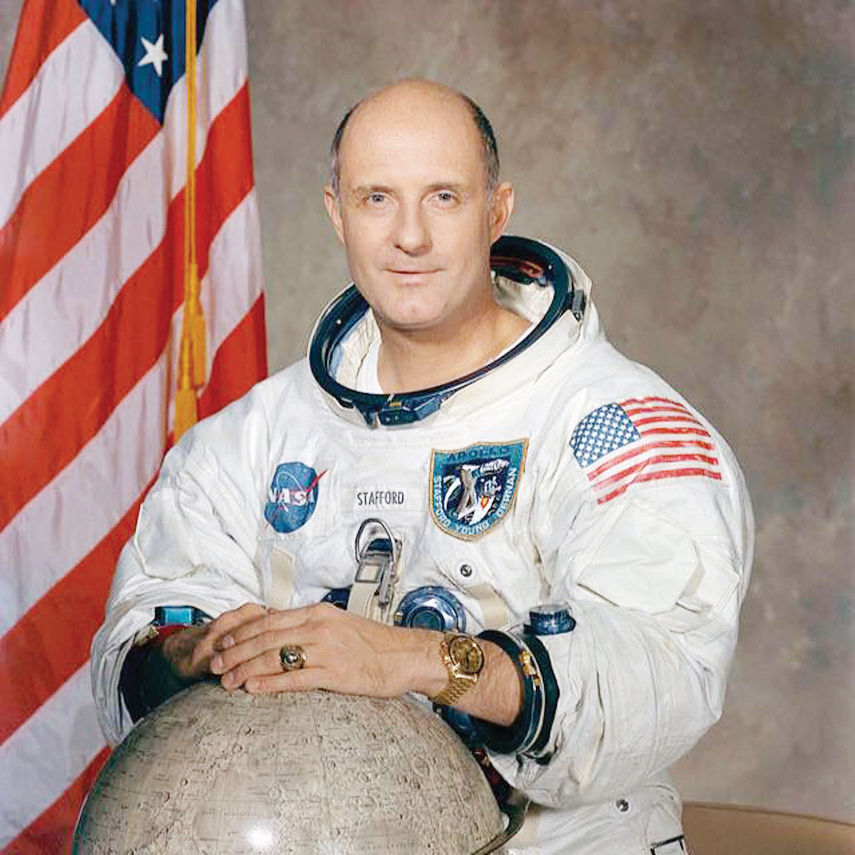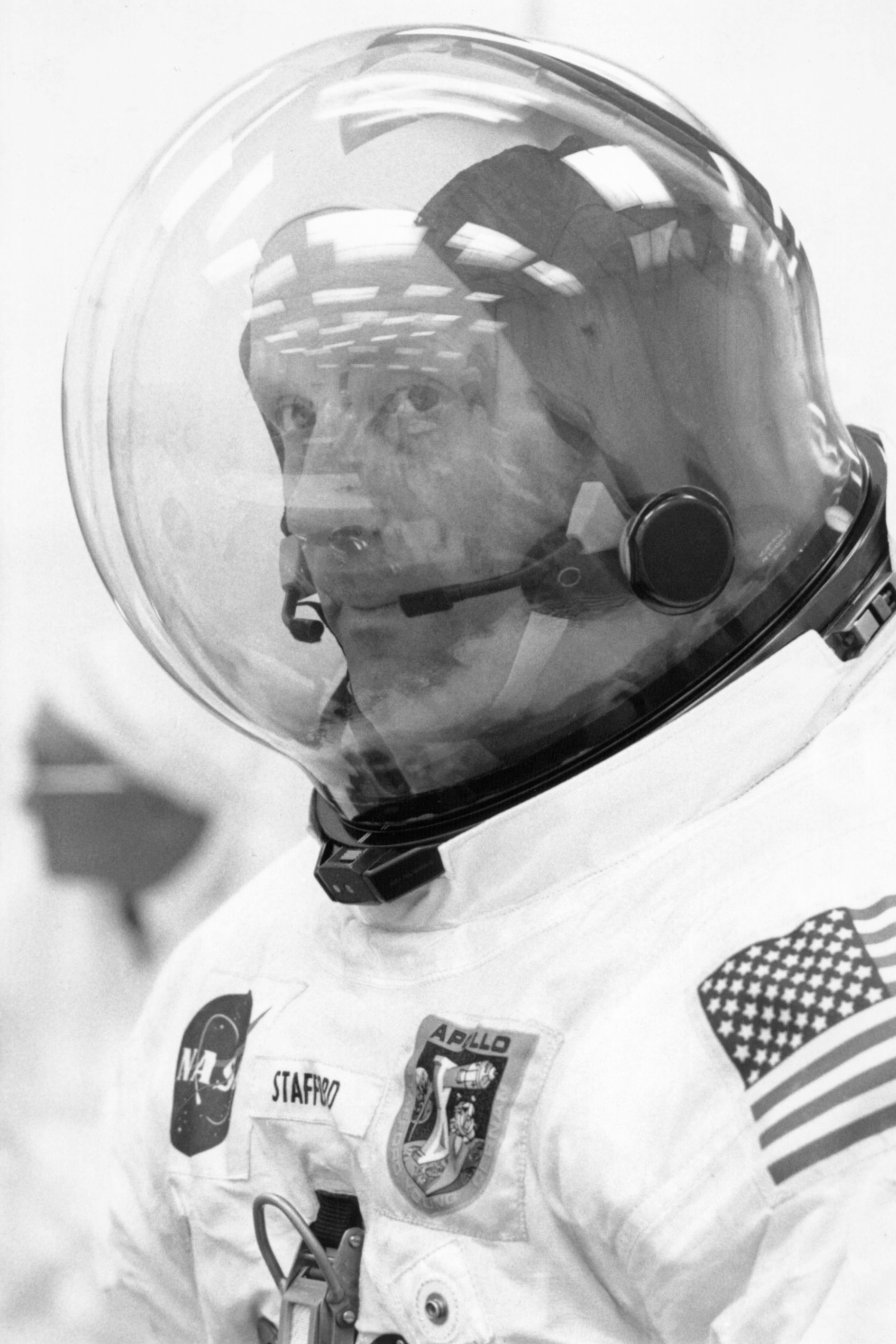The fastest living human on Earth is about to celebrate a major milestone!
Oklahoma astronaut and aerospace legend, General Thomas P. Stafford, will celebrate his 90th birthday on September 17th. Stafford, who was the veteran of four space missions, including three as mission commander. Upon returning to the Earth from his Apollo 10 mission to the moon, Stafford, and fellow crewmates, John Young and Gene Cernan, slammed back into the atmosphere at a speed of 24,791 mph – or nearly seven miles a second. It established the all-time human speed record that still stands today more than a half century after it was set. Stafford was the Commander of the mission, and the only living member of that historic mission crew.
After his graduation from Weatherford High School, and the U.S. Naval Academy at Annapolis, Stafford became a fighter pilot, and was selected to the elite U.S. Air Force Test Pilot School at Edwards Air Force Base, California, where he graduated number one in his class. He went on to test many supersonic aircraft in the late 1950’s and early 60’s. By the end of this Air Force career, Stafford would have flown nearly 130 types of military aircraft, and several types of helicopters.
On his 32nd birthday in 1962, Stafford was informed by NASA that he had been selected to join eight other elite test pilots in the second class of astronauts to be selected by the space agency. On his first space mission, Stafford would pilot the Gemini 6 spacecraft that would perform one of the greatest milestones in spaceflight, the first successful rendezvous in orbit with other spacecraft – a maneuver that many thought was impossible due to its complexity. Without accomplishing this difficult maneuver would make future moon landing impossible. Just six months later, Stafford would be orbiting the Earth again, commanding the Gemini 9 mission. This established a record for the shortest period of time between two missions that an astronaut would fly.
After the completion of the Gemini Program, Stafford was named to command the Apollo 10 mission to the moon. After Apollo 8 successfully orbited the moon in late 1968, the planned mission schedule would have made Apollo 10 as the first attempt to make a lunar landing, and for Stafford to become the first man to walk on the moon. But, as fate would have it, the highly complex Lunar Module spacecraft that would carry the astronauts to the lunar surface was about two months behind schedule, and still too heavy for Apollo 10 to attempt the landing. Instead, Stafford and his Apollo 10 crew would fly the complete profile of a landing, including being the first to fly the Lunar Module into lunar orbit, and flying it down to within 47,000 feet of the surface. It would be the final full-scale dress rehearsal prior to the Apollo 11 crew’s successful landing just two months later.
Upon returning from the moon, Stafford would be chosen to serve in a variety of NASA administrative capacities, including Chief of the Astronaut Corp. Stafford would then be selected to command his fourth and final space mission in 1975 that would have international implications. The Cold War was at its peak, and had squared off the world’s two great superpowers, the U.S. and the Soviet Union, in a nuclear standoff that had brought the world to the brink of World War III on several occasions. In an effort to find some common ground, and to defuse the tension, both nations signed an agreement to fly a joint mission in space named the Apollo-Soyuz Test Project (ASTP). It would be a mission of great political risk for the U.S. and the Soviets. If the mission proved to be a success, the Cold War tension might be defused. If it failed, the future of the world might be at risk! Stafford was named to lead the American side, and Alexei Leonov – the first person to walk in space – would lead the Soviet crew. Stafford and Leonov would become very close, lifelong friends, and the mission would go on to be a huge success. Many historians today consider the success of the Apollo-Soyuz mission to have been the beginning of the end of the Cold War, and Stafford would be nominated for the Nobel Peace Prize for his efforts.
During this time, Stafford would be the first astronaut to become a General, and the first General to fly in space.
After his Apollo-Soyuz mission, General Stafford resigned from NASA, and reentered the Air Force, where he received his second and third stars. He was named to Command the Flight Test Center at Edwards, AFB., California where all Air Force test pilots are trained, and all new experimental aircraft are tested. At the same time, Stafford would assume the command of the famous Groom Lake Test Facility in Nevada, better known as “Area-51.” It was here that projects that were considered to be “above Top-Secret” were conducted. General Stafford would then be assigned to the Pentagon as Deputy Chief of Staff for all Air Force Research Development and Acquisition. It was during this time, that Stafford would become the “Father of Stealth Technology.” His vision of the importance of Stealth would move the technology from the abstract, theoretical level, to actual practical use. His efforts would lead to the development of the F-117A Stealth fighter, and the B-2 Stealth bomber.
General Stafford would retire from the Air Force in 1979. He would go on to form an aerospace consulting firm, and serve on many corporate boards, including numerous Fortune 500 companies. He continued to work closely with NASA, and was asked to form and lead numerous special committees for the space agency – work that continues to this day. He still is asked to do technical consulting for members of Congress, the Department of Defense, and various aerospace corporations on matters of space exploration technology. Even at the age of 90, Tom Stafford still Chairs NASA’s primary Oversight Committee on Space Station Safety and Operations – a position that requires him to travel to Russia several times a year to assure that the Russian Space Agency is living up to their responsibilities in the operation of the International Space Station (ISS).
For his seven decades of commitment to this nation, and the development of aviation and spaceflight, General Stafford has been awarded hundreds of awards and honors for his accomplishments. He was named as Oklahoma’s Aviator of the Century, and is one of only a few living astronauts to be awarded the Congressional Space Medal of Honor. He has won the prestigious Harmon Trophy, not once, but twice; the Wright Brothers Memorial Award; the James Doolittle Award; the American Institute of Aeronautics and Astronautics (AIAA) Award, The Von Braun Medal for Space Exploration, and hundreds of other honors, including an Emmy Award for his development of a compact color TV camera that he carried on Apollo 10 to send the first live color television images back from space. As the late U.S. Senator, and first U.S. astronaut to orbit the Earth, John Glenn, said about Stafford: “There have been few people that have impacted the development of aviation and space exploration in this country as much as Tom Stafford.”
Still a consummate engineer and brilliant mathematician, Stafford has calculated that he has travelled 52,560,000,000,000 (52 trillion, 560 billion miles) during his 90 orbits around the Sun. That does not include the approximately 2.6 million extra miles he travelled during his four space missions.
To celebrate this milestone birthday, the Stafford Air & Space Museum in Stafford’s hometown of Weatherford, Oklahoma, will have free admission Thursday, September 17th. The museum has planned a special “Member-Only” event for the evening of his birthday Thursday evening. For information about becoming a member, contact Teresa Schoonmaker at 580-772-5871, or at Teresa@cityofweatherford.com.
On Saturday, September 19th, the museum will host a public celebration of General Stafford’s birthday. There will be free admission to the museum all day. A large banner will be located in the lobby for visitors to sign and express their birthday wishes to General Stafford. The banner will be sent to him after the celebration. Food trucks will be on site for lunch. Beginning at noon, birthday cake will be served (until it runs out). Covid-19 precautions will keep Stafford from travelling to Weatherford, but at 1:30, a special live video interview will be conducted with General Stafford from his home in Florida. Special seating distancing will be observed, so seating is limited. The public will be invited to ask the General questions about his life and career. A free special commemorative poster will be made available to all museum visitors that day to take home. The museum asks that all visitors who come to the museum to adhere to current Covid precautions, and it is recommended that masks be worn.
The Stafford Air & Space Museum is an official Affiliate organization of the Smithsonian’s National Air & Space Museum, and one of the most comprehensive aerospace museums in the Central United States. It is one of only three air and space museums in the United States to be rated as a “Five-Star” attraction by TripAdvisor, the world’s leading travel rating service.
For further information, call the Stafford Museum at 580-772-5871.




